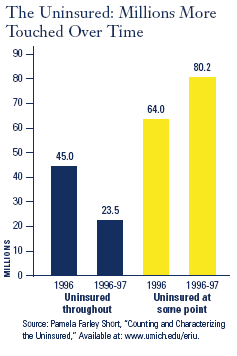|



The University of Michigan
555 South Forest Street
Third Floor
Ann Arbor, MI 48104-2531
T 734-936-9842
F 734-998-6341
/
|
 |
 |
A Revolving Door: How Individuals Move In and Out of Health Insurance Coverage THE PROBLEM
Many health care experts think of the more than 41 million
Americans without health care coverage as a group of
chronically uninsurable individuals whose status rarely
changes. However, research shows that the uninsured are
a dynamic, diverse, and constantly evolving pool of people
that encompasses many more individuals. When tracking
uninsured people over a two-year period, health economists
find that millions more Americans - a total of 80 million -
actually lack health insurance for some period.
A review of research on the uninsured, conducted for The
Economic Research Initiative on the Uninsured (ERIU)
at the University of Michigan by Pennsylvania State
University health economist Pamela Farley Short, Ph.D.,
shows that many individuals quickly move in and out of
coverage. Short found that most studies of the uninsured
portray a partial picture because they only look at a snapshot
in time. Longitudinal research by Short, Harvard
University's Katherine Swartz, Ph.D., and others provides
a more complete picture that debunks widely held assumptions
about the uninsured. Gaining a better view of who
comprises this group is important for policymakers trying to craft viable solutions to the problem.
|
|
"The research highlighted here demonstrates
how critical it is to provide
health policymakers and researchers
with careful analyses of the uninsured.
Failing to understand who the uninsured
really are can lead to unintended
consequences and wasted resources
when designing fixes.
Consider coverage gaps experienced
by older adults, who are more medically
vulnerable. A recent ERIU-funded
analysis of people in their 50s and early
60s revealed that while 90 percent
were insured at any point in time,
22 percent were without coverage
at some time between 1992 and 1998.
A five-to-six month coverage gap for
this population can impose serious
financial burdens and jeopardize
timely treatments.
Current employment-based strategies
miss opportunities to prevent gaps.
ERIU estimated that 40 percent of all
workers were without private coverage
at some point during 1996-1998.
More than half of the gaps were
because of a job change. Automatic
enrollment into continuing coverage
under COBRA would eliminate these
gaps in uninsurance."
From Catherine McLaughlin,
Ph.D., Professor at the University of Michigan and Director of
ERIU |
THE FACTS
-
Who they are. The uninsured are made up of both short-term and chronically uninsured people. Half of the uninsured go without coverage for six months or less, while more than 40 percent are uninsured for at least 18 months.
-
Evaluating the problem. The magnitude of the uninsured problem depends on how it is measured. More than 41 million Americans are uninsured at any given point but that number multiplies when the uninsured are tracked over time, even for one year (see chart at right).
-
Jobs and coverage in flux. Health care coverage fluctuates because of changes in individual income and job status. Many people continually move in and out of jobs, and/or in and out of poverty, affecting eligibility for employer-sponsored insurance or public programs.
-
At greatest risk. The chances of regaining health coverage decrease the longer a person remains uninsured. Hispanics, people who don't work, and high school dropouts are more likely to experience longer uninsured spells than other groups.
-
Not just poor. Millions of more affluent individuals lose or are at risk of losing coverage. Sixteen million Americans who lost coverage between 1996 and 1997 had incomes at least 400 percent of the federal poverty level. Higher wage earners tend to be uninsured for shorter periods of time.

Q&A with Pamela Farley Short, Ph.D.
Pamela Farley Short, Ph.D., Professor of Health Policy and Administration at Pennsylvania State University, has spent the last 20 years examining issues about the uninsured and what leads people to lose their health care coverage. Short, who recently wrote the paper "Counting and Characterizing the Uninsured" for ERIU, talks about why it's critical that policymakers understand who comprises the uninsured.
Q: Why don't policymakers have a good understanding of who the uninsured really are?
A: It comes down to how we count the uninsured. At least six different surveys produce information on the uninsured. Different surveys focus on different time frames so the statistics coming from different surveys have very different interpretations. Usually, policymakers rely on data that report the number of uninsured from a point in time, instead of over a period of time.
Q: What's the problem with looking at the number of uninsured at a point in time? And what does that mean for designing programs to cover the uninsured?
A: It significantly understates the number of people in the U.S. who are going to lose their health insurance over a period of time, and it overstates the number of people who are really long-term uninsured.
First, counting the uninsured over time makes you realize that a lot more people, and many higher-income people, are at risk of losing their coverage. Secondly, when policymakers fail to recognize that many people move in and out of coverage it's very easy to design programs that will cause new uninsured gaps and cost more than expected.
Q: What's the impact on health care policy of so many people quickly transitioning in and out of coverage?
A: As we focus on incremental strategies to cover the uninsured, policymakers are trying to "paint" coverage on certain groups of the uninsured, such as poor kids or the parents of poor kids by changing eligibility for Medicaid or CHIP. However, because peoples' jobs and income status change, the people you paint with coverage today with these programs may no longer qualify tomorrow. Tomorrow they may find coverage on their own, or they may be uninsured. Policymakers are aiming at a moving target when they try to design programs to insure the uninsured.
Q: Should policymakers focus on how to keep people from becoming uninsured and shortening the time that people go without coverage, instead of covering the uninsured?
A: Yes. Once you begin to think of "uninsured" as referring to gaps in time, instead of people, then you ask questions like, "How many of the uninsured would be covered if we got people onto coverage faster and kept them on longer? How many gaps can we eliminate?" Such strategies would truly reduce the number of uninsured.
We need to think about providing people with a stable source of coverage, and not create programs that will continue to cause gaps. Instead of moving people from one insurance program to another, move the dollars around.
Full
Q&A with Pamela Farley Short, Ph.D.
|
UPCOMING
|
This Research Highlight is the first in a
series of research-based policy documents that will address current questions and issues related to the health care coverage debate.
Future documents will examine the causes and consequences of being uninsured and the impact of rising costs on health insurance coverage.
Research Highlights can be found on ERIU's website at . |
Other ERIU Research Highlights
ERIU Working Paper #2 (Adobe PDF)

Back to top

Funded by The Robert Wood Johnson Foundation, ERIU is
a five-year program shedding new light on the causes and consequences
of lack of coverage, and the crucial role that health insurance plays
in
shaping the U.S. labor market. The Foundation does not endorse the findings
of this or other independent research projects.
|
